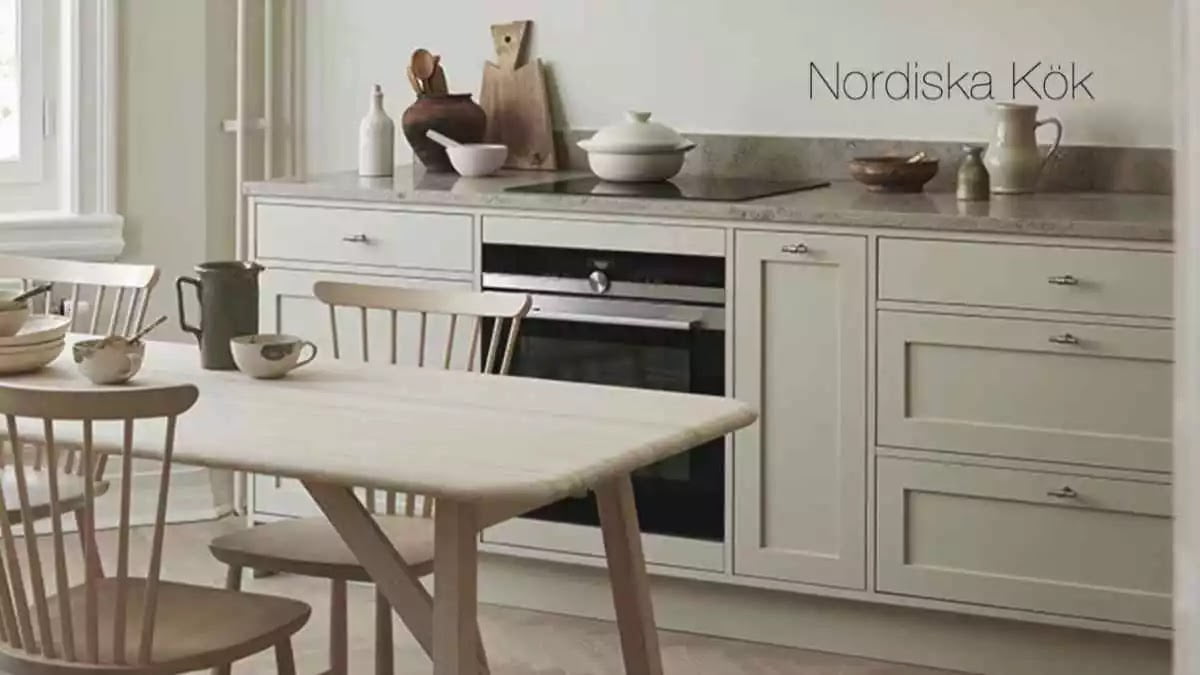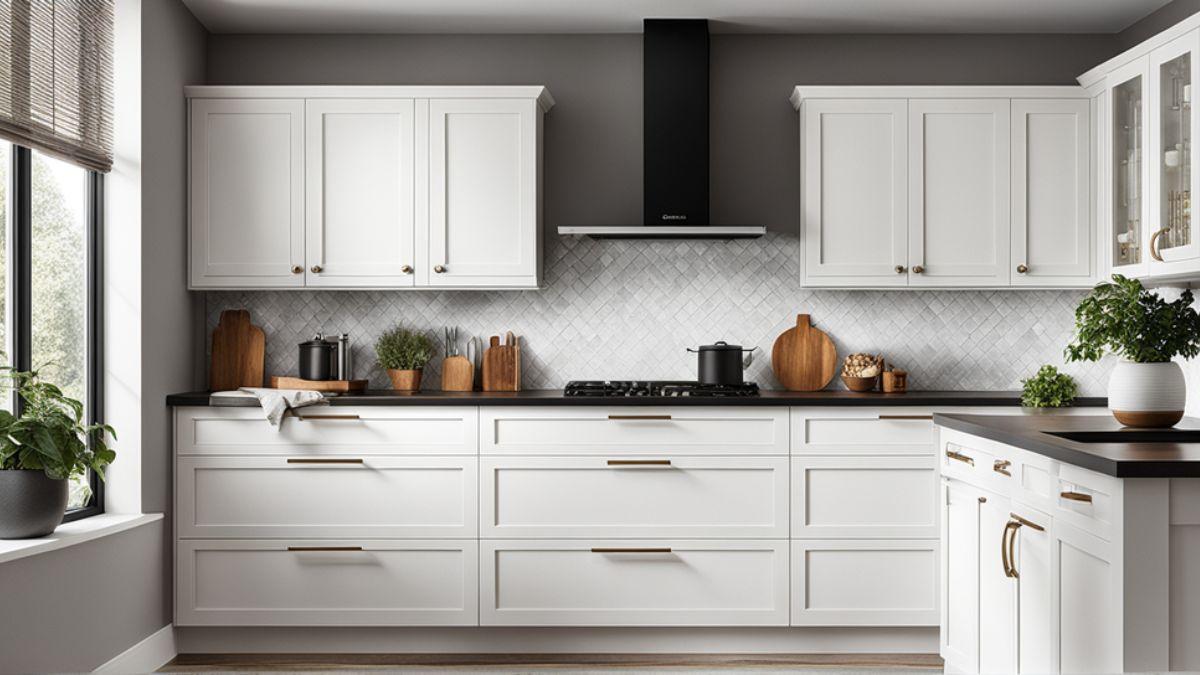
We may earn money or products from the companies mentioned in this post.
Are you considering remodeling your kitchen and getting rid of the top cabinets? Clever move. A room might seem more open and breezy when there isn’t a wall of cabinets looming above in the kitchen. But weigh the benefits and drawbacks of a kitchen without top cabinets before you tear them out.
- Positively, a kitchen seems larger and more airy when the visual area above the worktops and appliances is opened up. Additionally, it lets in more natural light into the space. Reducing clutter and forcing you to simplify the necessities are two other benefits of having no cabinets.
- Obviously, you’ll need to find other ways to keep things organized if you lose all that storage space. More open space also means more cleaning; because there are no cupboards to conceal sloppy spills, you’ll need to maintain immaculate countertops, appliances, and backsplashes.
- Nevertheless, the advantages of an open, minimalist kitchen still exceed the drawbacks for a large number of homeowners and tenants. A kitchen without top cabinets may be fashionable, useful, and ideal for your space with some clever storage ideas and a commitment to reducing clutter. These are some suggestions and pointers to get you going if you’re prepared to make the move.
Pros of a Kitchen Without Upper Cabinets
A kitchen without upper cabinets opens up the space, making it feel more airy and relaxed. Here are some of the main pros to consider:
- Increased natural light. Removing upper cabinets allows more light to filter into the kitchen from windows and skylights. This makes the space feel more open and bright.
- Easier to clean. With fewer cabinets and surfaces, there’s less to dust and wipe down. You can focus on keeping essential surfaces like the counters and stovetop clean.
- Stylish and modern look. A kitchen without upper cabinets has a sleek, minimalist vibe that’s on-trend. It helps create a contemporary, high-end look if that’s the style you’re going for.
- Fewer items on display. For those with a more sparse kitchenware collection, a kitchen without upper cabinets keeps things looking tidy and decluttered. Only your most used and favorite items will be out on the counters.
- Easy to reach items. Without upper cabinets, everything is within easy reach. No more climbing up to get plates or straining to reach items stored up high.
- Flexible space. The open area above the counters can be used for floating shelves, an extractor hood, or left open for an airy feel. You have options to design the space in a way that suits your needs and style.
While a kitchen without upper cabinets isn’t for everyone, for those who prefer an open, minimalist space, the pros can make it an inspiring choice. With some creative design ideas, you can have a fully functional yet stylish kitchen that makes a statement.
Cons to Consider When Removing Upper Cabinets
Removing your upper cabinets opens up your kitchen in a big way, but it does come with some downsides to consider before taking the plunge.
Cons to Consider
One of the biggest cons is losing storage space. Upper cabinets typically provide a lot of storage for everything from dishes and glassware to spices and canned goods. Without them, you’ll need to find alternate storage solutions, like:
- Built-in shelving
- Pantry cabinets
- Drawer dividers for cutlery and utensils
- Decorative baskets for items on countertops
- A kitchen island with storage
Another consideration is increased dusting and cleaning. More open shelving means more surfaces to keep tidy. Be prepared to dust and wipe down open shelves and any items stored on them regularly.
You may also face higher heating and cooling costs. Upper cabinets help insulate kitchen walls, so removing them can make your HVAC system work harder to regulate the temperature in your home.
Lastly, open shelving isn’t for everyone’s decorating style. If you prefer a more minimalist look or get stressed by clutter and mess, open shelving may not suit your needs. In that case, you may want to do closed cabinetry on the lower portion of the walls and more decorative open shelving higher up.
While removing upper cabinets isn’t for every kitchen, with some strategic design planning you can enjoy an open, airy space without sacrificing function. Think about what’s most important for your needs and style, and you’ll find a solution that works.
Design Ideas for Open Shelving Instead of Upper Cabinets
Open shelving in place of upper cabinets offers some attractive benefits for a kitchen. Here are a few design ideas to consider:
Use matching shelves for a cohesive look
Choose shelving units that complement your existing cabinetry or countertops. Wood shelves pair nicely with wood or stone counters, while metal shelves match well with stainless steel appliances. For a custom look, have shelves cut to fit your exact wall dimensions.
Group items by use
Organize your shelves in a practical way. Group all glasses, mugs, and cups on one shelf. Have a shelf dedicated to plates and bowls. A spice rack shelf keeps all seasonings within easy reach. This makes items simple to find when cooking and baking.
Add lighting
Install under-cabinet or puck lighting to brightly illuminate your open shelves. Not only does this highlight your decorative items and collections, but it also makes it easier to see what you need when reaching for dishes or ingredients.
Use risers and labels
For an orderly look, use risers, organizers and matching containers to corral smaller items on your shelves. Label or group similar items together. This prevents a cluttered, messy appearance and makes things quicker to spot.
Leave some empty space
Don’t feel the need to fill every inch of your open shelving. Leaving some empty space makes a kitchen feel more open and airy. It also gives you room to add new items or rearrange as needed. Aim for filling about two-thirds of your shelving, leaving the rest open.
Open shelving offers a stylish, minimalist look for any kitchen. With some simple organization and design techniques, you can create functional and fashionable shelving to replace your upper cabinets.
Maximizing Storage in a Kitchen Without Upper Cabinets
Without upper cabinets, you’ll need to get creative to maximize your kitchen storage. Here are some ideas to help you make the most of your space:
Open Shelving
Open shelving is a great way to display items while still keeping them within easy reach. Use matching shelves on one kitchen wall for frequently used dishes, glasses, and linens. For a cohesive look, choose shelving in a style and finish that complements your lower cabinets and countertops.
Cabinet Fronts Only
If you want the streamlined look of a cabinet-free wall but still need enclosed storage, install cabinet fronts only. The fronts provide a furniture-like facade, but behind them you’ll find open shelving or cubbies to store items out of sight. This is a good option if you want to hide small appliances or other clutter.
Pull-Out Pantry
A pull-out pantry maximizes vertical space while keeping everything neatly organized and accessible. Have a cabinetmaker install pull-out drawers or trays that glide out for easy access to spices, snacks, pots and pans. For narrow spaces, a pantry that pulls out on tracks is ideal.
Kitchen Island
An island is the perfect solution for a kitchen without upper cabinets. Choose an island with lots of drawer and cabinet space to store essential tools, linens, and more. For extra function, look for an island with seating, bookshelves, towel racks, or a sink. Islands on casters let you move them around as needed.
Hanging Racks
Install hanging racks from the ceiling to free up wall space. Use racks for pots, pans, utensils, and linens. For a stylish touch, choose racks with an industrial flair like steel mesh or wire. Make sure racks are secure and able to handle the weight of the items you want to store on them before loading them up.
With some innovative storage solutions, a kitchen without upper cabinets can be highly functional and fashionable. Focus on maximizing vertical space, keeping necessities within easy reach, and choosing multifunctional furniture like islands to give you more storage and work area in your cabinet-free kitchen.
How to Decide if a Kitchen Without Upper Cabinets Is Right for You
Deciding if a kitchen without upper cabinets is right for your space comes down to a few key factors. Think about how you use your kitchen and what’s most important in the design.
Storage Needs
Do you have a lot of small appliances, pots, and pans, or pantry items that typically get stored in upper cabinets? If so, eliminating them altogether may not provide enough storage space for your needs. Consider options like:
- Open shelving: Install a few open shelves at eye level to display items and still have storage.
- Tall pantry cabinet: Add a freestanding pantry cabinet for additional storage.
- Drawers: Use deep drawers in the lower cabinets and in any islands to store items that would typically go in upper cabinets.
Style Preferences
A kitchen without upper cabinets has a more open, modern feel. If you prefer a traditional kitchen style, upper cabinets are typically included. Think about the look you want and what will match your home’s architecture and decor. An open-concept kitchen, in particular, benefits from the spaciousness provided by eliminating upper cabinets.
Budget
Removing upper cabinets can save money on cabinetry. However, you’ll need to weigh the cost savings versus any additional storage furniture or shelving needed. Installation of full-height backsplashes, lighting fixtures, or wall art to fill the open space left by the upper cabinets should also be considered in the budget.
Resale Value
If you may sell your home in the near future, a kitchen with traditional cabinetry typically has the broadest appeal. However, open-concept, contemporary kitchens are also popular in many markets. Check with a real estate professional to determine what style of kitchen would have the best resale value based on trends in your local area.
In the end, you need to go with what will make you happy in your own home. Think about how a kitchen without upper cabinets would function for your lifestyle and if the pros outweigh any potential downsides. If done right, it can result in a beautiful, inviting space you’ll love spending time in.
Conclusion
That’s the dirt on lowering the ceiling in your kitchen to make it seem more posh. Although removing the top cabinets might be a daring decision, the functional and stylistic benefits are well worth the consideration. Your open-concept kitchen will seem lighter and more roomy. Your culinary creations will be prominently displayed. And you’ll still be able to easily access anything if you have some thoughtful storage options in place. If you’re unsure whether to get rid of the uppers, start by clearing off a single portion to make more room. If you decide you don’t like it, you can always put them back. However, it’s likely that once you feel the liberation of an unrestricted kitchen, you’ll get addicted. So go ahead and open that fantasy kitchen of yours!
More Best Kitchen Cabinets recommendations
- Corner Kitchen Sink Cabinets: Maximize Space and Functionality
- Kitchen Cabinet Glass: Stylish and Functional
- Light Brown Kitchen Cabinets: A Stylish and Versatile Choice
- Open Kitchen Cabinet Ideas: Inspiration for a Stylish and Functional Kitchen
- White Kitchen Cabinet Hardware Ideas for Every Style
- Kitchen Without Upper Cabinets: Pros, Cons, and Design Ideas
- Open Kitchen Cabinets No Doors: Inspiration, Benefits, and Tips
- Floor To Ceiling Cabinets for Kitchen: Maximize Storage and Style







